
Sexual and Gender Diverse Women Curriculum
Understanding the wellbeing of lesbian, bisexual, transgender, and queer (LBTQ+) women
- Home
- Sexual and Gender Diverse Women Curriculum
* Disclaimer *
This presentation uplifts sensitive, enlightening, and potentially triggering discussion topics. Certain topics are empowering and others are challenging to speak about. All feelings are welcome in this space. It may be hard to discuss these topics, it is harder to experience the challenges presented in many of the topics, and that is why we are here.

This project was Made Possible by a Grant from the California Commission on the Status of Women and Girls (CCSWG), and Created by Los Angeles County Commissioner Dr. Bobbie Emetu
Sexual and Gender Diverse Women Curriculum
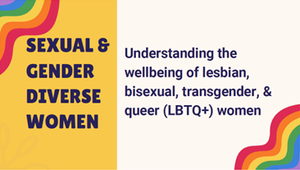
The Sexual and Gender Diverse Women Curriculum was initiated and coordinated by Commissioner Dr. Bobbie Emetu to educate, empower, and support professionals, advocates, and service providers in delivering inclusive, affirming, and culturally responsive care to women who identify across the spectrums of sexual orientation and gender identity. Grounded in intersectionality and community-informed best practices, this curriculum seeks to increase awareness, reduce disparities, and foster equity by addressing the unique experiences, needs, and systemic barriers faced by lesbian, bisexual, queer, transgender, nonbinary, and other gender-diverse women in Los Angeles County and beyond.
Access Curriculum
Click HERE to watch the training WITHOUT Captions.
Click HERE to watch the training WITH Captions.
Additional Training Tools, and Resources Coming Soon!
WORDS AND TERMS OF LGBTQ+
It Gets Better Project (n.d.)
Language
Sexual Orientation:
An individual's emotional, romantic, and/or sexual attraction to other people
- Gay: An individual who is attracted to those of their same gender; often used as an umbrella term
- Lesbian: A woman who is attracted to other women; some women prefer to identify as gay women instead of lesbian
- Bisexual: An individual who is attracted to those of their same gender as well as to those of different genders, though not necessarily in the same way or to the same degree; often used as an umbrella term for people who are attracted to more than one gender–closely related to pansexual
- Pansexual: An individual who is attracted to all gender identities
Gender Identity:
A person's deeply held internal sense of their gender; they can identify as being male, female, or somewhere else along the gender continuum; this is not visible to others
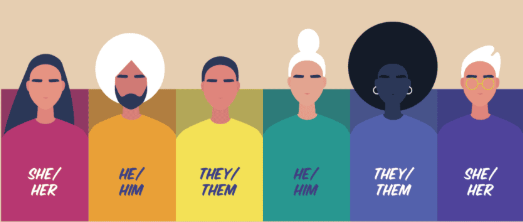
Gender Expression:
The external representation of gender expressed through such components as names, pronouns, clothing, haircuts, behavior, voice, and more.
Sex:
At birth, infants are assigned a sex based on the appearance of their external anatomy; this is often confused with gender. A person's sex is actually a combination of bodily characteristics, as a result, sex is not just binary male/female (and neither is gender)
Pronouns:
Linguistic tools that are used to refer to people and honor their gender identity

Cisgender:
A term describing people whose gender identity and/or expression aligns with the cultural expectations based on the sex assigned to them at birth
Transgender:
A term describing people whose gender identity and/or expression is different from the sex they were assigned at birth
Nonbinary:
A term describing people whose gender identity and/or expression does not conform to the social/cultural expectations of male or female; it can be an umbrella term to describe identities that do not fall within the binary system, but rather on the gender spectrum
- Genderqueer, genderfluid, gender nonconforming, bigender, agender, Two-Spirit
Queer:
An umbrella term used to describe fluid sexual orientations, gender identities, and/or gender expressions.
History
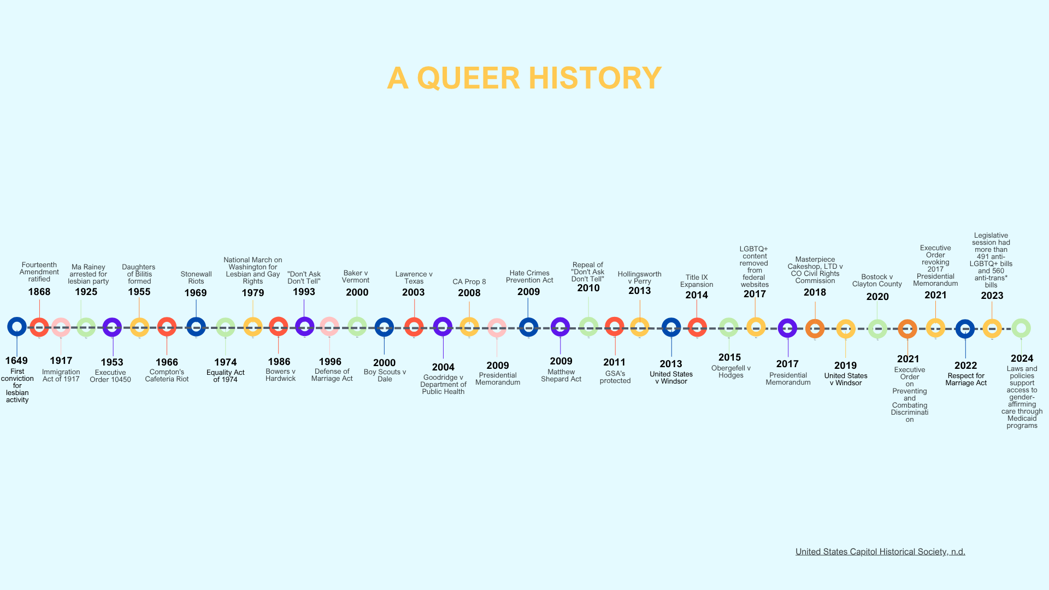
Transgender Healthcare
HRC Foundation, 2023, Williams Institute, 2023, Austin et al., 2022, Bustos et al., 2021, Wilson, Ronnekleiv-Kelly, and Pawlik

Transgender Healthcare
- Gender-affirming care is life-saving healthcare for transgender, non-binary, and gender diverse individuals. Gender-affirming care is medically necessary for the well-being of many transgender and gender diverse people who experience gender incongruence.
- Research shows that 86% of transgender youth have considered suicide and 56% have attempted suicide. Access to gender-affirming care reduces lifetime suicidal ideation by 70%.
- Less than 1% of individuals that seek gender- affirming care regret their decision. This is less than the 14.4% of the general population that regrets general surgical procedures.
- Every major medical organization supports gender-affirming care as evidence-based, best medical practice. This includes the American Academy of Pediatrics, American Medical Association, Endocrine Society, and American Psychiatric Association.
- Youth with access to puberty blockers report lower depression and suicidality.
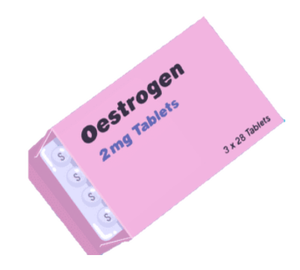
Transgender Healthcare
- 24 states ban best practice medication and surgical care for transgender youth
- 6 states have bans that make it a felony crime to provide best practice medical care for transgender youth
- 2 states (AR, MS) explicitly permit insurers to refuse to cover gender affirming care
- AR law allows refusal of coverage for everyone, regardless of age
- MS law allows refusal for minors
- 14 states explicitly exclude gender-affirming care from their state employee health benefits
- 2 states (AR, MS) Medicaid policies explicitly exclude transgender related health care for minors
- 10 states’ Medicaid policies explicitly exclude transgender related health care for all ages
Movement Advancement Project, 2023
Gender Minority or Gender Diverse
It Gets Better Project, (n.d.)
All people for whom their gender identity or gender expression varies from the binary sex they were assigned at birth
Terminology evolution
Transvestite -> transsexual -> transgender Nonbinary, genderqueer, and gender fluid
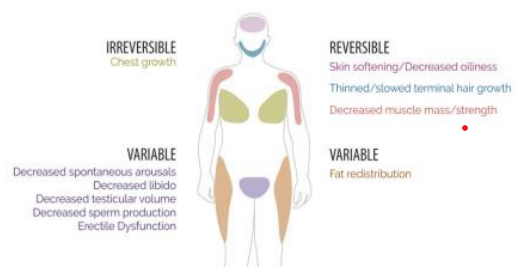
Feminizing Hormones
- Counteract effects of endogenous testosterone
- Typically take both an antiandrogen and estrogen
- May also take a cyclical regimen of progesterone
- Desired effects ⚬ Softening of the skin (reversible)
- Thinning and slowed growth of body hair (reversible)
- Loss of muscle tone (reversible)
- Breast growth (irreversible)
- Potential side effects
- Decrease in libido
- Risk for heart disease and breast cancer
Hormone and Surgical Risks
- Most of the risks involve moving from a “male” risk level to a “female” risk level
- Risks associated with estrogen treatment
- Deep vein thrombosis, gallstones, weight gain, elevated liver enzymes, and hypertriglyceridemia
- Few studies have been completed that explore the long-term health risks of hormone treatment
- Feminizing surgical risks
- Risks associated with a vaginoplasty
- Fistula, granulation tissue, urinary tract infections, and issues with sensation and orgasm
- Risks associated with a vaginoplasty
Gender Minority Adolescent Health
It Gets Better Project, (n.d.)

Puberty Blocking
Pubertal suppression
- Peri-adolescents
- Gonadotropin-releasing hormone agonist
- Completely reversible
Hormone treatment
- Puberty congruent with affirmed gender identity
- Documented benefits of pubertal suppression followed by hormone treatment
Fertility
Fertility preservation options
- Pre- or peripubertal
- Ovarian or testicular tissue cryopreservation
Postpubertal
- Cryopreservation of oocyte or embryo
- Sperm banking
Identity Development
Identity development processes
- Gender identity development
- Early onset gender dysphoria
- Pubertal-onset gender dysphoria
Sexual orientation identity development
- Between childhood and adolescence, typically after gender identity
- Youth who discover their gender minority identity at the onset of puberty are more likely to identify as sexual minorities.
Options
- Transgender girls
- Antiandrogen medication
- Blocks further masculinization from endogenous testosterone
- However, treatment option provides the feminization that many gender minority adolescents desire
Barriers
- Barriers to puberty-blocking medication. Parental support and consent is necessary.
- Medical providers lack training
- Youth and families are not aware of options
- Cost is rarely covered by health insurance
- Up to $20,000 annually
Support
- Parental acceptance and support
- Predictors of positive mental health outcomes
- Role of mental health and medical providers
- Educate parents about the negative health outcomes associated with rejection
- Normalize gender minority identities and gender identity and expression exploration ⚬ Provide resources in their local communities
GENDER-NEUTRAL DIALOGUE
National LGBT Health Education Center, 2016

Pronouns + Gender Neutral Terms
“Hi, my name is Dr. Stone and I use she/her/hers pronouns. How about you, what is your name and what pronouns do you use?”
- Repeat the terms your client uses to describe themselves.
- If someone identifies themselves as “lesbian”, use that term rather than “queer”.
Use Gender Neutral Terms
- Person
- Partner
- Official Name (Sequoia)
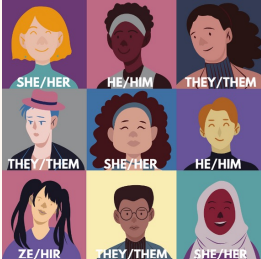
Caring: Feel & exhibit concern for others
Open: Desire to listen & receive information; and understand another person without prejudice and judgment
Respectful: Treat others with consideration, courtesy, and high regard
Empathetic: Understand other’s experiences and communicate your understanding

Why do pronouns matter?
Agency: Centers the person’s agency to define themselves for themselves.
Autonomy: Allows a person to define themselves by their own standard, independent of societal expectations.
Acknowledgement: Allows others to acknowledge a person for how they exist.
Access: The practice of sharing pronouns empowers all humans to be respected when accessing healthcare services.
Navigating Implicit Bias
Accountability
Abandon the right/wrong binary.
- Imagine: Yes...and!
Gender Equity is not a destination.
- It is a journey.
“Never a failure, always a lesson.”*
- Loss vs. Lesson

Implicit Bias
- Most of the risks involve moving from a “male” risk level to a “female” risk level
- Risks associated with estrogen treatment
- Deep vein thrombosis, gallstones, weight gain, elevated liver enzymes, and hypertriglyceridemia
- Few studies have been completed that explore the long-term health risks of hormone treatment
- Feminizing surgical risks
- Risks associated with a vaginoplasty
- Fistula, granulation tissue, urinary tract infections, and issues with sensation and orgasm
- Risks associated with a vaginoplasty
What you can do as an Ally in Action!
Gibbs, 2021, and Lewis, 2017

Stand up, even if you are nervous.
- Don’t let the fear of being wrong paralyze into inaction.
Be willing to challenge the status quo.
- Your voice matters. You are the only one with it.
Hold yourself and your circle accountable.
- Align your vision and values with your choices, and you will be equipped to invite other allies to do the same.
Share the benefits of your privilege.
- Simply remembering that we do not have to understand someone, to respect and support them, can have an exponential impact on your compassion.
Allyship
The State or Condition of BEING an Ally
Sequoia Speaks, 2024, and Gibbs, 2021
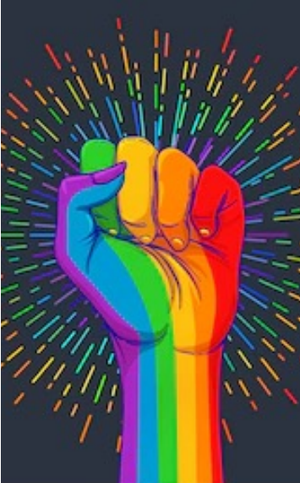
Inquire rather than assume.
- Seek out the information you do not understand.
Align your intentions with your actions.
- Performing is to appease an audience.
- Allyship is to align your intentions with your choices, principles, and behaviors.
Reflect, Research, and Return.
- Assuming is a human thing; we all do it.
- We do not have to subscribe to our assumptions
Build a relationship with hearing “no”.
- Curiosity and intention do not obligate a “teachable moment.”
- Cultivate dialogue practices to navigate discomfort.
Remember, danger and discomfort... are different.
- You may be in discomfort, while that person, has been in danger in spaces where you can safely exist without fear.
Own Intentions. Respect Impact:
- Taking accountability for behaviors is not an admittance of wrongness.
- An apology and an acknowledgment can go a long way.
Additional Questions?
Contact Commissioner Dr. Bobbie Emetu: laccw@bos.lacounty.gov
Healthcare Resources
National LGBTQIA+ Health Education Center - The Fenway Institute
LGBTQIA+ Health Education Center
A Toolkit for Collecting Data on Sexual Orientation and Gender Identity in Clinical Settings
Institute of Medicine
The Health of Lesbian, Gay, Bisexual, and Transgender People (IOM Report)
Collecting Sexual Orientation and Gender Identity Data in Electronic Health Records (IOM Report)
Human Rights Campaign - Healthcare Equality Index (HEI)
2024 Healthcare Equality Index Report (HEI Report)
- Publicizing Patient Non-discrimination Policies
- HEI Equal Visitation Policies
- HEI Employment Non-discrimination
- Training in LGBT Patient-Centered Care (HEI Training)
Support Resources
The Trevor Project
CALL 1-866-488-7386
TEXT START TO 678-678
- Crisis Text Hotline
- TEXT HOME TO 741741
Black Emotional Mental Health (BEAM)
National Alliance on Mental Illness (NAMI) Helpline
1-800-650-NAMI (6264)
Trans Lifeline*
R.A.I.N.N. (Rape, Abuse & Incest National Network)
1-800.656.HOPE (4673)
V. Zepeda